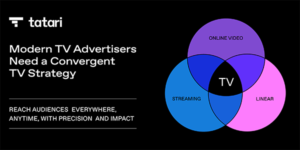To say that OTT is on the rise in 2020 may be a bit of an understatement. As more viewers cut the cord in favor of streaming services, the streaming wars are heating up, and the playing field is becoming crowded with platforms.
Last year saw the launch of OTT platforms Apple TV Plus and Disney+, while HBO Max is slated to launch in May. Even cable giants like Comcast have recognized the direction viewership is going, and are poised to claim their piece of the streaming pie. NBCUniversal, a subsidiary of Comcast, is launching Peacock, an ad-supported streaming service, in April.
If you’re not on board already, 2020 may be the year to incorporate OTT into your digital marketing plan. Need more convincing? Let’s take a look at some striking statistics that reflect the state of OTT in 2020.
But first, a quick primer to make sure you’re up to speed on all things OTT.
What Is OTT?
Over the top (OTT) content is streamed through the internet and watched on smart TVs, phones and streaming devices such as Roku, Apple TV or Amazon Fire TV. In other words, it’s content that’s served up over the internet, rather than through cable or satellite TV.
Connected TV and OTT are not the same thing. While they’re closely related, they’re not synonymous. Connected TV refers to the device that you watch OTT content on. OTT, on the other hand, is the method of delivery: over-the-top (or bypassing) cable and satellite TV.
Three Benefits Of OTT Advertising
There are myriad reasons marketers are earmarking more of their budget for OTT advertising. Here are three big benefits that OTT advertising has to offer:
• Hyper-target your audience.
OTT gives marketers the ability to target TV audiences on a much more granular level than traditional TV. How? From online browsing information to purchase history, online data allows you to identify and reach specific audience segments with highly personalized messaging.
• Retarget across channels.
OTT advertising allows you to retarget through web and mobile traffic to complete the cross-channel marketing loop. With the help of website retargeting, IP targeting and device thumbprints, marketers can retarget a consumer that has seen their ad on streaming TV on their computer or mobile phone.
• Precise attribution tracking.
Unlike traditional TV advertising, OTT allows you to track the success of your marketing efforts. The ability to connect an ad view with a website visit, download or sale can help marketers see what’s working and get an accurate read on their ROI.
The State Of OTT In Statistics
With all of that in mind, let’s take a look at the state of OTT advertising in 2020. From cord-cutting to streaming viewership to ad spend, everything OTT appears to be on the rise in 2020.
More Viewers Are Cutting The Cord
Variety reports that satellite and TV companies lost a whopping 6 million customers in 2019. That’s a sharp increase from previous years and a trend that will no doubt continue. According to research from a consumer analytics firm, Resonate, a total of 53 million people have cut the cord so far.
Emarketer estimates that between 2019 and 2023, the number of households in the U.S. that subscribe to pay TV will decline from 86.5 million to 72.7 million.
A closely related trend worth noting is “cord stacking,” in which a pay-TV subscriber also views content via streaming services. Running ads on both traditional and streaming TV can have a strong impact on viewers. Research found that launching streaming and traditional TV ads in tandem increased ad recall by 34%.
OTT Viewership Is Increasing
Another study by Roku found that viewers of streaming TV in the U.S. could surpass traditional pay-TV viewership within five years. The research predicts that 60 million households will watch content on their TV exclusively through streaming services by 2025, which would likely trump traditional TV viewership by then.
As for the small screen, a study by OpenX and The Harris Poll found that OTT consumers use their mobile devices for more than six hours a day and watch more than two hours of mobile video daily. Millennial OTT users stream more video content on their mobile device than their TV sets.
That said, OTT is no longer the sole province of millennials and is quickly becoming mainstream. The same study found that 52% of U.S. adults (over 18) use at least one OTT service, while almost a third of Americans 55 and older watch OTT content.
OTT Ad Spend Is Growing
Emarketer predicts (paywall) that OTT ad spend will hit $9 billion in the U.S. this year, up 28% year over year, and will reach a staggering $14.6 billion by 2023. It also reports that 50% of U.S. agency and marketing professionals expect to increase ad spend on OTT/connected TV channels within the next 12 months.
In a report, Pixilate found that OTT/CTV ad volume in the United States increased by 330% in 2019 — including a significant 74% rise in Q4 alone. This upward trend doesn’t appear to be confined to the U.S. The same report noted a 330% rise in worldwide programmatic OTT/CTV ad transactions in 2019.
Ad Revenue From OTT Is On The Rise
According to the “Global OTT TV and Video Forecasts” report by Digital TV Research, ad revenue from connected TV campaigns reached nearly $68 billion in 2018 and will reach just over $158 billion by 2024.
Needless to say, the state of OTT advertising is strong and quickly gaining momentum.
OTT advertising is a highly effective way to reach a specific audience with personalized messaging across multiple platforms. As viewing patterns and preferences continue to evolve, are your marketing efforts poised to tap into these new opportunities to connect with your customers?


